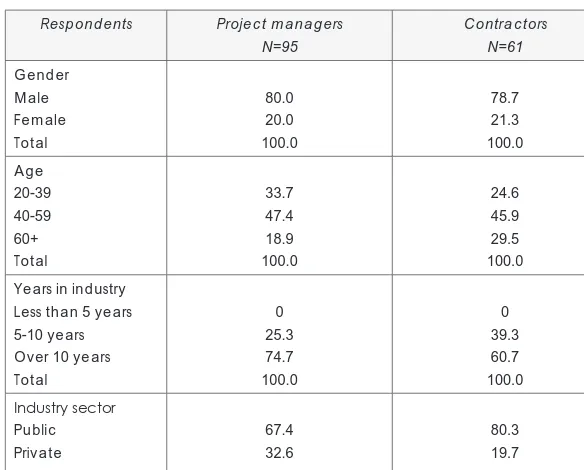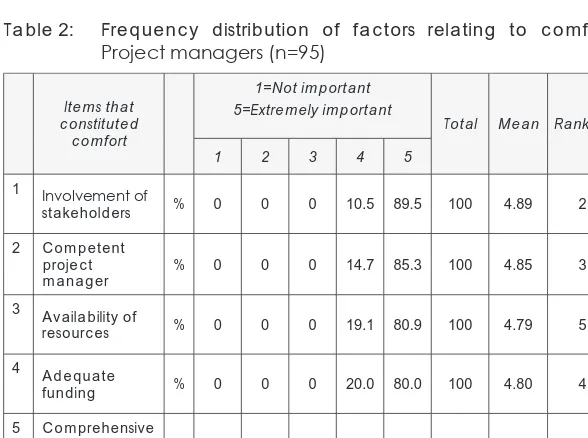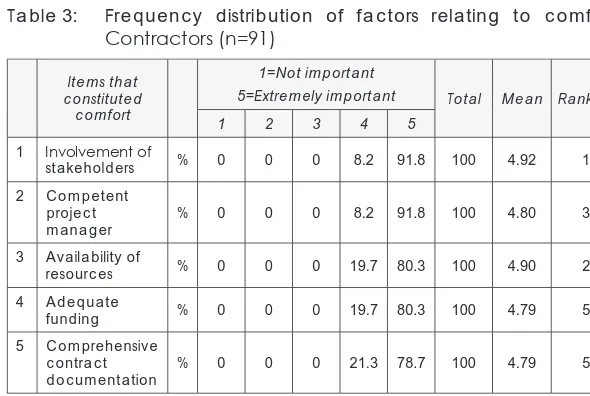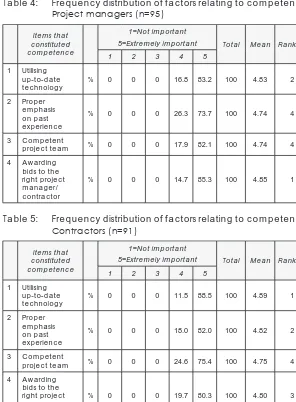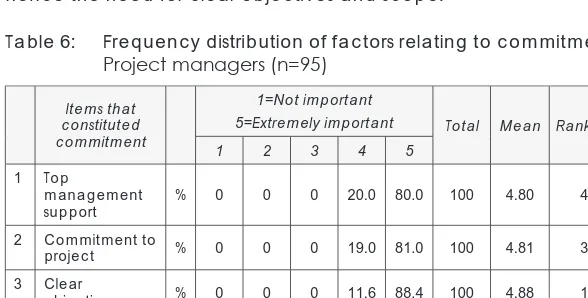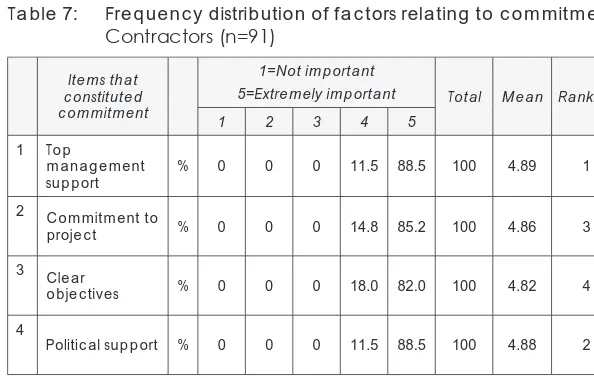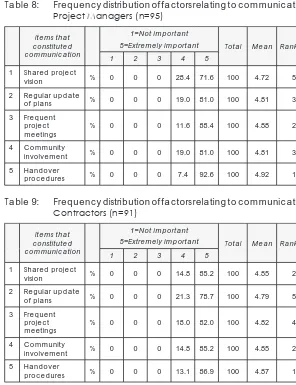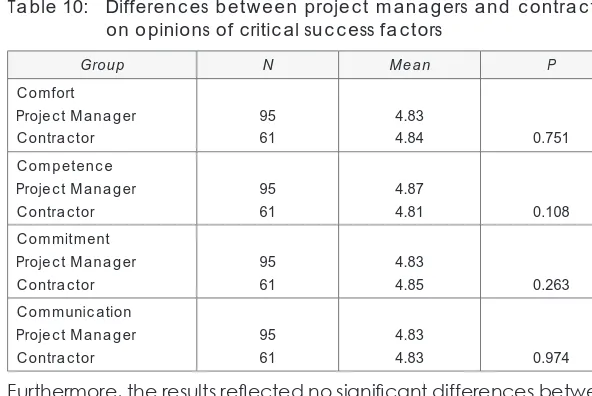Hari Garbharran, Jeevarathnam Govender &
Thulani Msani
Critical success factors influencing project
success in the construction industry
Peer reviewed
Abstract
The construction industry is one of the largest job creators in developing countries and is highly competitive. The high number of project failures suggests the existence of underlying critical success factors which have not been identified. This article assesses the perceptions of contractors and project managers on the critical success factors that lead to project success in the construction industry. This article is based on the four COMs model (comfort, competence, communication and commitment). A survey was conducted among 95 project managers and 61 active grade four contractors in Durban, South Africa. The findings reveal that both project managers and contractors strongly support the identified critical success factors as significant in achieving project success. There was no significant difference in their perception of critical success factors, based on the biographic characteristics. The recommendations presented may be used as a guideline for successful execution of construction projects. Keywords: Critical success factors, project success
Dr Hari Lall Garbharran, Research Coordinator, Department of Management Accounting, Durban University of Technology, PO Box 1334, Durban 4000. Phone: +27 31 3735740, email: <garbharranHL@dut.ac.za>
Dr Jeevarathnam Parthasarathy Govender, Senior Lecturer, Department of Marketing and Retail Management, Durban University of Technology, PO Box 1334, Durban 4000. Phone: +27 31 3735396, email: <govendej@dut.ac.za>
Mr Thulani Armstrong Msani, Project Head, Edison Power Group, PO Box 4115, Umhlanga Rocks, Durban 4320. Phone: +27 31 5669500, email: <thulani@edisonpower.co.za>
Abstrak
Die konstruksiebedryf is een van die grootste werkskeppers in ontwikkelende lande en is hoogs mededingend. Die hoë aantal projekmislukkings dui op die bestaan van onderliggende kritiese suksesfaktore wat nog nie geïdentifiseer is nie. Hierdie artikel poog om waarnemings wat kontrakteurs en projekbestuurders van die kritiese suksesfaktore in die konstruksiebedryf gemaak het, te bepaal. Die vier COMs-model (comfort, competence, communication en commitment) is gebruik om as basis vir hierdie studie te dien. Die opname is gedoen onder 95 projekbestuurders en 61 aktiewe graad-vier kontrakteurs, in Durban, Suid-Afrika. Die bevindinge het getoon dat beide projekbestuurders en kontrakteurs die kritiese suksesfaktore betekenisvol vind en sterk ondersteun, om projek sukses te bereik. Daar was geen betekenisvolle verskil in hul waarneming van kritiese suksesfaktore gebaseer op die biografiese kenmerke nie. Die aanbevelings wat gemaak word, kan as riglyn vir die suksesvolle uitvoering van konstruksieprojekte gebruik word.
Sleutelwoorde: Kritiese suksesfaktore, projeksukses
1. Introduction
Project success has eluded the construction industry to the point where keeping existing clients has become a battle, let alone attracting new clients (Toor & Ogunlana, 2005: 150). An assumption is made that, if a project is completed on time, within the agreed budget and set quality, referred to as the ‘golden triangle’, then the project is deemed successful. Evidence suggests that this is far from the truth. Hence, the construction industry needs to pay special attention to critical success factors, besides the ‘golden triangle’, if it is to survive the challenges posed by globalisation (Toor & Ogunlana, 2005: 154).
Zwikael (2009: 381) believes that the work of construction companies is project-oriented, i.e., it is unique and has a definite start and finish point. This requires the use of project management tools and techniques as opposed to conventional management techniques. Proper usage of project management tools within the project life cycle ensures smooth execution of activities. The project life cycle is the framework upon which the project is carried out. The project manager acts as a single point of contact responsible for harnessing identified critical success factors towards achieving project success. According to Yang, Shen & Ho (2009: 162), the unique nature of projects dictates that critical success factors identified in one industry cannot be directly transferred to other industries. The similarities found in the construction industry in developing countries such as South Africa make sharing of knowledge easier.
Acta Structilia 2012: 19(2)
the advent of globalisation (Nguyen, Ogunlana & Lan, 2004: 409). Contractors, consultants and project managers in South Africa are finding it increasingly difficult to attract new clients. In addition, it is not clear as to what actions need to be taken in order to improve project success. According to Ojiako, Johansen & Greenwood (2008: 414), project success in the construction industry in South Africa and in most developing countries is measured by the ‘golden triangle’ parameters of time, cost and quality. The high number of project failures suggests the existence of underlying critical success factors which have not been identified. This article, therefore, seeks to identify the critical factors that lead to project success.
Achieving project success is becoming more important in the highly competitive construction industry. Large and complex construction projects are becoming more difficult to complete successfully in developing countries (Swan & Khalfan, 2007: 123). It is against this background that this article focuses on critical success factors pertaining to the construction industry in Durban, South Africa. Han, Yusof, Ismail & Choon (2012: 90) advocate the suitability of the 4 COMs model proposed by Nguyen, Ogulana & Lan, which is considered suitable for application in emerging economies. The aim of this article is to assess the perceptions of contractors and project managers regarding critical success factors which lead to project success in the construction industry in Durban, South Africa.
2.
The four COMs
Critical success factors are those inputs to the project management system that directly increase the likelihood of achieving project success. Nguyen, Ogunlana & Lan (2004: 404-413) identify and group success factors under four categories which are referred to as the ‘four COMs’, viz., comfort, competence, commitment and communication.
2.1 Comfort
such an individual should possess both technical skills, which include being a subject matter expert and having an in-depth knowledge of structures, and “soft” skills, which include team management, emotional intelligence, transformational leadership and conflict management. According to Newton (2005: 110), the availability of resources is a further critical factor. A resource management plan needs to be developed in conjunction with all relevant stakeholders. Competition for resources is a common phenomenon in projects. Unexpected developments during the course of the project must be carefully managed in terms of resource planning. It must be ensured that there is adequate funding throughout the project. A financial plan, which takes into account the project activity schedule, needs to be developed. Finally, there must be comprehensive contract documentation. It must be ensured that all relevant stakeholders enter into contractual agreements regarding activities and performance during the course of the project. Cost, time and quality parameters need to be specified so that performance can be assessed (Johnson, Scholes & Wittington, 2006: 826).
2.2 Competence
Acta Structilia 2012: 19(2)
when selecting contractors include company track record, quality management, health and safety, and technical proficiency (Philips, Martin, Dainty & Price, 2008: 312).
2.3 Commitment
Commitment emphasises the support of top management, commitment to the project, clear objectives and scope, and political support. The support of top management goes beyond the provision of funds and making resources available (Johnson, Scholes & Wittington, 2006: 504). Kerzner (2006: 200) believes that commitment to the project is very closely linked to a sense of collectivism, rather than individualism. An environment needs to be created, in which team members experience job satisfaction and are, therefore, motivated to be part of the team. Optimal performance by team members is important. Having clear objectives and scope are key in providing direction to team members. Objectives must be clear and scope should be as simple as possible in order to avoid “grey areas”. It is inevitable that changes will occur during the course of the project. Flexibility and adaptability are, therefore, central to achieving success. Finally, political support is important for project success, given that a large proportion of projects are public projects. To this end, support from non-governmental organisations and the ruling party is important (Jacobson & Choi, 2008: 646).
2.4 Communication
liaison between the project manager and the community (Teo, 2010: 222). Finally, proper handover procedures need to be developed. This is an important consideration, given that the construction industry is being increasingly viewed as a service industry (Karna, Junnon & Sorvala, 2009: 117).
3.
Research methodology
Being a quantitative study, the survey method was used to gather primary data (Easterby-Smith, Thorpe & Jackson, 2008: 11). The study is descriptive and cross-sectional in nature. The study was confined to commercial projects, hence excluding residential construction. There were two target populations, namely project managers and contractors who worked on both private and public sector projects. Project managers comprised independent professional practitioners who are principal agents that were the interface between the client and the contractor. The contractors were those parties who did the actual construction work. For the purpose of this study, only active contractors classified as Construction Industry Development Board (CIDB) grade 4 were selected. Population details of contractors were obtained from the CIDB register which indicated the population size of active grade 4 contractors as 68 within the greater Durban area (Register of Contractors, 2010). Population details in respect of project managers were obtained from the South African Council for Project and Construction Management Professions, which indicated a population size of 101 for the Durban area. An attempted census was conducted owing to the relatively small population sizes. According to Brown & Suter (2008: 113), a census is a type of sampling plan where data is collected from every member of a population. Questionnaires were, therefore, personally administered, by both the researcher, as well as through the employment of graduate assistants, to 101 project managers and 68 contractors. Ninety-five project managers and 61 contractors responded, constituting a response rate of 95% and 90%, respectively.
Acta Structilia 2012: 19(2) Manya et al • Governance structures
closed-ended questions using a five-point scale (not important – extremely important, where 1 indicates not important and 5, extremely important). Closed-ended questions were preferred, as they reduce the respondent’s bias and facilitate coding of the questionnaire (Akintoye & Main, 2007: 597-617). Respondents were given the opportunity to make relevant comments at the end of the questionnaire. Descriptive and inferential statistics were used to analyse the quantitative data. The data analysis was performed using the Statistical Package for Social Sciences (SPSS). The level of significance was set at 95% (p= 0.05).
4.
Findings and discussion
4.1 Biographical data
The results, indicated in Table 1, show that the vast majority of respondents were male, with 80% of project managers and 79% of contractors being male, clearly indicating the dominance of males in the sector. The largest proportion of respondents for both project managers and contractors was in the 40-59 age group (47.4% of project managers and 45.9% of contractors). Interestingly, 18.9% of project managers and 29.5% of contractors were over 60 years of age. This suggests a need for capacity replacement in the long term, as the latter group is expected to retire in a few years’ time. All the respondents have over five years’ experience in the industry, with 74.7% of project managers and 60.7% of contractors having over 10 years’ experience in the industry. This can be attributed to the fact that it takes a significant number of years to gain enough experience and a good reputation which would enable one to do consulting or undertake challenging projects.
Table 1: Biographical details of respondents
Respondents Project managers N=95 Contractors N=61 Gender Male Female Total 80.0 20.0 100.0 78.7 21.3 100.0 Age 20-39 40-59 60+ Total 33.7 47.4 18.9 100.0 24.6 45.9 29.5 100.0 Years in industry
Less than 5 years 5-10 years Over 10 years Total 0 25.3 74.7 100.0 0 39.3 60.7 100.0 Industry sector Public Private Total 67.4 32.6 100.0 80.3 19.7 100.0
4.2 Findings and discussion on the ‘four COMs
The following is a descriptive account of respondents’ opinions on the importance of the elements that constitute the ‘4 COMs’ 4.2.1 Comfort
Acta Structilia 2012: 19(2)
a greater appreciation for consultation with the relevant interest groups. Swan & Khalfan (2007: 120) advise that the inclusion of all stakeholders, including the public, is essential for successful project delivery. Yang, Shen & Ho (2009: 166) believe that the project manager has to identify the interests of all relevant stakeholders and ensure that there is buy-in to the project. Anantatmula (2010: 14) believes that a competent project manager is able to carefully define roles and responsibilities of project team members. According to Newton (2005: 110), a resource plan has to be adequately developed and distributed to every section involved in the project. In addition, Johnson, Scholes & Whittington (2006: 305) stress the importance of adequate funding throughout the project. This will ensure that no activity is hampered, due to funding shortages. The importance of contract documentation is highlighted by Kerzner (2006: 826), who suggests that, if no contract is signed, it would be difficult to ensure performance of the necessary activities.
Table 2: Frequency distribution of factors relating to comfort: Project managers (n=95)
Items that constituted
comfort
1=Not important 5=Extremely important
Total Mean Ranking
1 2 3 4 5
1 Involvement of
stakeholders % 0 0 0 10.5 89.5 100 4.89 2
2 Competent project
manager % 0 0 0 14.7 85.3 100 4.85 3
3 Availability of
resources % 0 0 0 19.1 80.9 100 4.79 5
4 Adequate
funding % 0 0 0 20.0 80.0 100 4.80 4
5 Comprehensive contract
[image:9.463.58.352.248.467.2]Table 3: Frequency distribution of factors relating to comfort: Contractors (n=91)
Items that constituted
comfort
1=Not important
5=Extremely important Total Mean Ranking
1 2 3 4 5
1 Involvement of
stakeholders % 0 0 0 8.2 91.8 100 4.92 1
2 Competent project
manager % 0 0 0 8.2 91.8 100 4.80 3
3 Availability of
resources % 0 0 0 19.7 80.3 100 4.90 2
4 Adequate
funding % 0 0 0 19.7 80.3 100 4.79 5
5 Comprehensive contract
documentation % 0 0 0 21.3 78.7 100 4.79 5
4.2.2 Competence
[image:10.463.71.366.56.254.2]Acta Structilia 2012: 19(2)
through the relevant interventions, with a view to having competent teams. Phillips, Martin, Dainty & Price (2008: 308) advocate the use of multiple criteria when selecting contractors. These criteria need to take into consideration, inter alia, track record, safety practices, quality management, technical ability, and, in South Africa, Black Economic Empowerment.
Table 4: Frequency distribution of factors relating to competence: Project managers (n=95)
Items that constituted competence
1=Not important
5=Extremely important Total Mean Ranking
1 2 3 4 5
1 Utilising up-to-date
technology % 0 0 0 16.8 83.2 100 4.83 2
2 Proper emphasis on past experience
% 0 0 0 26.3 73.7 100 4.74 4
3 Competent
project team % 0 0 0 17.9 82.1 100 4.74 4
4 Awarding bids to the right project manager/ contractor
% 0 0 0 14.7 85.3 100 4.85 1
Table 5: Frequency distribution of factors relating to competence: Contractors (n=91)
Items that constituted competence
1=Not important
5=Extremely important Total Mean Ranking
1 2 3 4 5
1 Utilising up-to-date
technology % 0 0 0 11.5 88.5 100 4.89 1
2 Proper emphasis on past experience
% 0 0 0 18.0 82.0 100 4.82 2
3 Competent
project team % 0 0 0 24.6 75.4 100 4.75 4
4 Awarding bids to the right project manager/ contractor
[image:11.463.57.353.142.544.2] [image:11.463.57.351.346.538.2]4.2.3 Commitment
The frequency distributions of items relating to commitment in respect of project managers, as indicated in Table 6, reveal that the items comprising the commitment dimension were regarded as ‘extremely important’ in over 80% of the instances. As reflected in Table 7, at least 82% of contractors regarded the items that constitute competence as being ‘extremely important’. Thus, the vast majority of respondents identified the commitment dimension as a critical success factor for the successful completion of construction projects. Project managers ranked political support as being the most important factor, whereas the support of top management was considered most important by contractors. Both parties ranked political support very highly, understandably, considering that the majority of projects are based in the public sector. Projects, especially public projects, are influenced by the politics of the day, hence the need for political support. Jacobson & Choi (2008: 646) identify non-governmental organisations and political parties as the key political players. According to Johnson, Scholes & Whittington (2006: 504), projects come about due to a strategic objective that the organisation has to achieve. The support of top management is, therefore, essential. Commitment to the project is vital. Having clear objectives and scope are key elements. Lindahl & Ryd, 2007: 152) believe that project objectives have to be iterated and validated on an ongoing basis. Forsythe (2008: 480) indicates that construction clients make quality judgments progressively throughout the project, hence the need for clear objectives and scope.
Table 6: Frequency distribution of factors relating to commitment: Project managers (n=95)
Items that constituted commitment
1=Not important
5=Extremely important Total Mean Ranking
1 2 3 4 5
1 Top
management
support % 0 0 0 20.0 80.0 100 4.80 4
2 Commitment to
project % 0 0 0 19.0 81.0 100 4.81 3
3 Clear
objectives % 0 0 0 11.6 88.4 100 4.88 1
[image:12.463.72.366.359.508.2]Acta Structilia 2012: 19(2)
Table 7: Frequency distribution of factors relating to commitment: Contractors (n=91)
Items that constituted commitment
1=Not important
5=Extremely important Total Mean Ranking
1 2 3 4 5
1 Top
management
support % 0 0 0 11.5 88.5 100 4.89 1
2 Commitment to
project % 0 0 0 14.8 85.2 100 4.86 3
3 Clear
objectives % 0 0 0 18.0 82.0 100 4.82 4
4
Political support % 0 0 0 11.5 88.5 100 4.88 2
4.2.4 Communication
[image:13.463.56.353.57.246.2]Table 8: Frequency distribution of factors relating to communication: Project Managers (n=95)
Items that constituted communication
1=Not important
5=Extremely important Total Mean Ranking
1 2 3 4 5
1 Shared project
vision % 0 0 0 28.4 71.6 100 4.72 5
2 Regular update
of plans % 0 0 0 19.0 81.0 100 4.81 3
3 Frequent project
meetings % 0 0 0 11.6 88.4 100 4.88 2
4 Community
involvement % 0 0 0 19.0 81.0 100 4.81 3
5 Handover
procedures % 0 0 0 7.4 92.6 100 4.92 1
Table 9: Frequency distribution of factors relating to communication: Contractors (n=91)
Items that constituted communication
1=Not important
5=Extremely important Total Mean Ranking
1 2 3 4 5
1 Shared project
vision % 0 0 0 14.8 85.2 100 4.85 2
2 Regular update
of plans % 0 0 0 21.3 78.7 100 4.79 5
3 Frequent project
meetings % 0 0 0 18.0 82.0 100 4.82 4
4 Community
involvement % 0 0 0 14.8 85.2 100 4.85 2
5 Handover
procedures % 0 0 0 13.1 86.9 100 4.87 1
4.3 Relationship between biographical variables and opinions on critical success factors
[image:14.463.70.366.59.444.2]Acta Structilia 2012: 19(2)
equally important to both industry players, that is, project managers and contractors.
Table 10: Differences between project managers and contractors on opinions of critical success factors
Group N Mean P
Comfort Project Manager Contractor
95 61
4.83
4.84 0.751
Competence Project Manager Contractor
95 61
4.87
4.81 0.108
Commitment Project Manager Contractor
95 61
4.83
4.85 0.263
Communication Project Manager Contractor
95 61
4.83
4.83 0.974
Furthermore, the results reflected no significant differences between male and female contractors as well as male and female project managers at the 95% level (p>0.05) of their perceptions of the critical success factors.
[image:15.463.56.352.95.293.2]the likelihood of project success. This is, to a large extent, due to the nature of the public sector projects. For example, the nature of stakeholders is more complex than in private sector projects. Public sector projects involve a multitude of stakeholders ranging from the local municipality to the affected community and even political parties with divergent interests. Hence, past experience in the public sector could enhance the likelihood of a project manager achieving success.
When asked to make additional comments which they viewed as critical for the successful completion of projects, a few respondents pointed to misunderstandings arising out of contractual documents, resulting in lawsuits and delays in payment from public sector clients, thus causing cash flow problems.
5. Conclusion
Given the difficulty in defining project success, the four COMs model has been advocated as being a useful tool in assessing project success, especially in developing countries. This article sought to assess the perceptions of project managers and contractors regarding the critical success factors that lead to project success. The findings suggest that both project managers and contractors strongly support the critical success factors identified in the four COMs model as being significant in achieving project success. It emerged that there were no significant differences between project managers and contractors regarding the critical success factors. The findings also show no significant differences between project managers and contractors on the biographical variables of gender, age, tenure in the industry and sector (public and private), and their perceptions of critical success factors.
6. Recommendations
Acta Structilia 2012: 19(2)
In order to avoid individualism, which can lead to declining commitment to a project, a clear line of responsibility should be demarcated, e.g., in the form of a linear responsibility chart. Tools such as a work breakdown structure (WBS) should be used to break down activities assignable to specific individuals. It is further recommended that working on several projects simultaneously should be avoided, as this may potentially compromise the quality of the project. The CIDB could institute legislation that allows contractors to work on a certain number of projects at a given interval of time. This legislation will also ensure that projects are evenly spread across contractors. In addition, awarding of bids to the right project manager or contractor in the public sector must be conducted by an independent body which is not aligned to the local authorities or municipalities. Organisations undertaking government work should lobby for more efficient payment processes, especially timeous payment. Delays in payment can place a burden on the liquidity position of operators. Another key issue that needs to be addressed is capacity-planning for the future in respect of project managers. The current situation reflects a dominance of males in the industry. Furthermore, a significant proportion of project managers and contractors are close to retirement age, making it necessary for the appropriate measures to be taken to ensure capacity in the industry in the future.
References list
Akintoye, A. & Main, J. 2007. Collaborative relationships in construction: The UK contractor’s perception. Engineering, Construction and Architectural Management, 14(6), pp. 597-617. Anantatmula, V.S. 2010. Project manager leadership role in improving project performance. Engineering Management Journal, 22(1), pp. 13-22.
Brown, T.J. & Suter, T. 2008. Marketing research. Mason: South Western-Cengage Learning.
Chan, A.P.C., Wong, F.K.W. & Lam, P.T.I. 2006. Assessing quality relationships in public housing. International Journal of Quality & Reliability Management, 23(8), pp. 909-927.
Forsythe, P. 2008. Modelling customer perceived service quality in housing construction. Engineering, Construction and Architectural Management, 15(5), pp. 485-496.
Han, W.S., Yusof, A.M. Ismail, S. & Aun, N.C. 2012. Reviewing the notions of construction project success. International Journal of Business Management, 7(1), pp. 90-101.
Jacobson, C. & Choi, S.O. 2008. Success factors: Public works and public-private partnerships. International Journal of Public Sector Management, 21(6), pp. 637-657.
Johnson, G., Scholes, K. & Whittington, R. 2006. Exploring corporate strategy. Text and cases. 7th edition. London: Pearson Education. Karna, S., Junnonen, J. & Sorvala, V. 2009. Modelling structure of customer satisfaction with construction. Journal of Facilities Management, 7(2), pp. 111-127.
Kerzner, H. 2006. Project management: A system approach to planning, scheduling and controlling. 9th edition. New Jersey: John Wiley & Sons Publications.
Kotler, P. & Keller, K.L. 2006. Marketing management. 12th edition. New Jersey: Pearson Education.
Limsila, K. & Ogunlana, S.O. 2008. Performance and leadership outcome correlates of leadership styles and subordinate commitment. Construction and Architectural Management, 15(2), pp. 164-184.
Lindahl, G. & Ryd, N. 2007. Client’s goals and the construction project management process. Facilities, 25(3/4), pp. 147-156.
London, K., Chen, J. & Bavinton, N. 2005. Adopting reflexive capability in international briefing. Facilities, 23(7/8), pp. 295-318. Malach-Pines, A., Dvir, D. & Sadech, A. 2009. Project manager – project (PM – P) fit and project success. International Journal of Operations & Productions Management, 29(3), pp. 268-291.
Melkonian, T. & Picq, T. 2010. Opening the “black box” of collective competence in extreme projects: Lessons from the French Special Forces. Project Management Journal, 41(3), pp. 79-90.
Muller, R., Spang, K. & Ozcan, S. 2009. Cultural differences in decision making in project teams. International Journal of Managing Projects in Business, 2(1), pp. 70-93.
Acta Structilia 2012: 19(2)
Nguyen, L.D., Ogunlana, S.O. & Lan, D.T.X. 2004. A study on project success factors in large construction projects in Vietnam. Engineering, Construction and Architectural Management, 11(6), pp. 404-413.
Ojiako, U., Johansen, E. & Greenwood, D. 2008. A qualitative re-construction of project measurement criteria. Industrial Management & Data Systems, 108(3), pp. 405-417.
Othman, A.A.E., Hassan, T.M. & Pasquire, C.L. 2004. Drivers for dynamic brief development in construction. Engineering, Construction and Architectural Management, 11(4), pp. 248-258.
Pathirage, C.P., Amaratunga, D.G. & Haigh, R.P. 2007. Tacit knowledge and organisational performance: Construction industry perspective. Journal of Knowledge Management, 11(1), pp. 115-126. Phillips, S., Martin, J., Dainty, A. & Price, A. 2008. Analysis of the quality attributes used in establishing best value tenders on the UK social housing sector. Engineering, Construction and Architectural Management, 15(4), pp. 307-320.
Register of Contractors 2010. [online.]. Available from: <http://www. registers.cidb.org.za/reports/contractorlisting.asp> [Accessed: 12 May 2010].
Samuelson, W.F. & Marks, S.G. 2006. Managerial economics. 5th edition. New Jersey: John Wiley & Sons.
Sekaran, U. 2003. Research methods for business: A skill-building approach. New York: Wiley & Sons.
Swan, W. & Khalfan, M.M.A. 2007. Mutual objective setting for partnering projects in the public sector. Engineering, Construction and Architectural Management, 14(2), pp. 119-130.
Toor, S. & Ogunlana, S.O. 2009. Construction professionals’ perception of critical success factors for large-scale construction projects. Construction Innovation, 9(2), pp. 149-167.
Yang, J., Shen, Q. & Ho, M. 2009. An overview of previous studies in stakeholder management and its implications for the construction industry. Journal of Facilities Management, 7(2), pp. 159-175.
